The Forest Between Us
Jason Goldman | 23rd January 2018 | bioGraphic
Western lowland gorillas dwell deep in the forests of the Congo Basin, but their days may be numbered if we can't bring them into the light.
During their first few weeks in Dzanga-Sangha National Park in 2011, wildlife photographers Anup Shah and Fiona Rogers didn’t once attempt to photograph the gorillas that had lured them from London to this little-known park in the Central African Republic. They first had to familiarize themselves with the gorillas. More importantly, the gorillas needed to become familiar with the photographers.
That’s no easy task with an animal as shy and elusive as the western lowland gorilla (Gorilla gorilla gorilla). When University of Stirling primatologist Liz Williamson first traveled to Gabon to study this subspecies in the 1980s, she could hardly find them. “I completed my Ph.D. without really seeing the gorillas,” she says. Some 30 years later, scientists like Williamson still have more questions than answers about these fascinating animals—creatures with whom we share the vast majority of our DNA.
Researchers don’t yet know, for example, the typical lifespan of a wild lowland gorilla. They don’t understand why lowland gorilla family groups always include just one male, whereas mountain gorilla families may contain up to three. Scientists are also still struggling to gain insights into lowland gorillas’ cognitive skills, their social dynamics, behavioral aspects of the group (often referred to as culture), and even simple facts about their population size and structure.
That’s no easy task with an animal as shy and elusive as the western lowland gorilla (Gorilla gorilla gorilla). When University of Stirling primatologist Liz Williamson first traveled to Gabon to study this subspecies in the 1980s, she could hardly find them. “I completed my Ph.D. without really seeing the gorillas,” she says. Some 30 years later, scientists like Williamson still have more questions than answers about these fascinating animals—creatures with whom we share the vast majority of our DNA.
Researchers don’t yet know, for example, the typical lifespan of a wild lowland gorilla. They don’t understand why lowland gorilla family groups always include just one male, whereas mountain gorilla families may contain up to three. Scientists are also still struggling to gain insights into lowland gorillas’ cognitive skills, their social dynamics, behavioral aspects of the group (often referred to as culture), and even simple facts about their population size and structure.
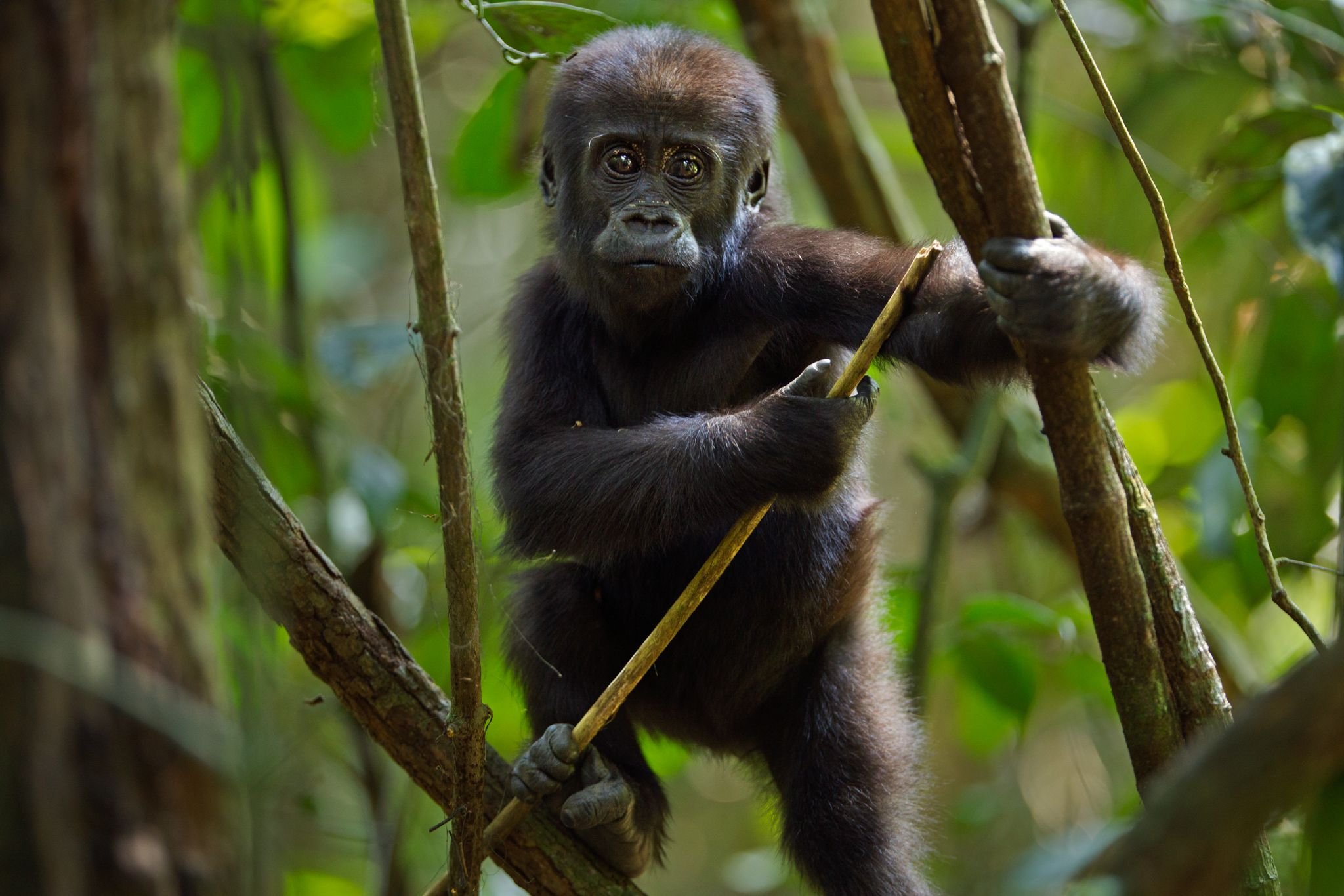
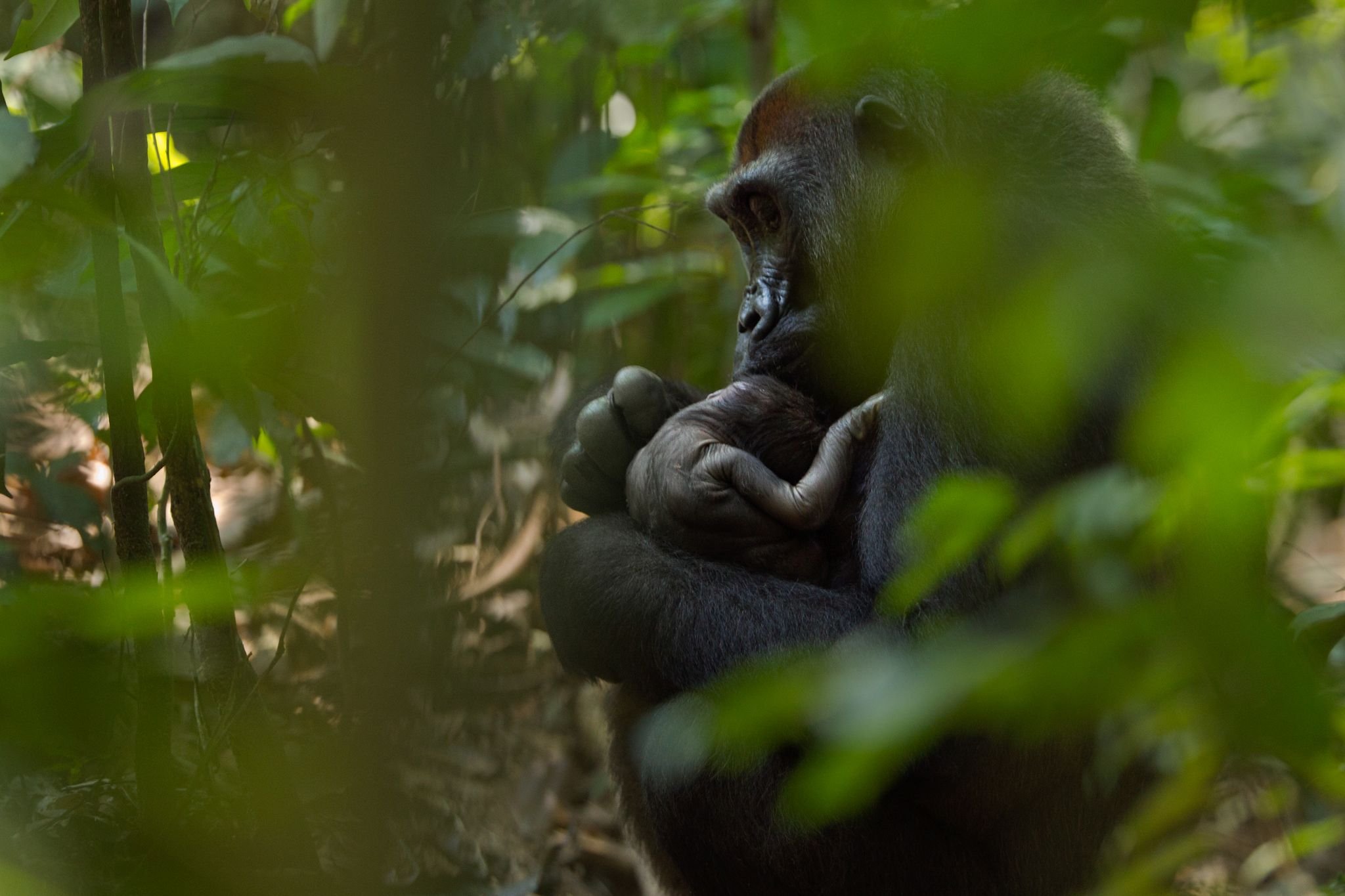
Today, observing the gorillas has become only slightly easier than when Williamson began her research. The process of habituation requires two deceptively simple things: You have to see the apes, and they have to see you. Such observations must happen over and over, until the gorillas become bored by your presence. Therein lies the challenge. Western lowland gorillas live in wide expanses of low-altitude forests. The terrain is flat but thick with trees, so visibility is limited to a dozen meters or so. As a result, encounters between western lowland gorillas and humans usually come as a surprise to both species. “You can't see them, and they can’t see you, until you’re extremely close,” Williamson says. Such encounters are understandably terrifying, especially considering gorillas’ long history of persecution at the hands of hunters.
Because of this history, habituation is ethically complex. In the short-term, it can be extremely stressful for the animals. But it offers researchers, conservationists, and tourists better access, which ostensibly improves the chances of implementing effective conservation measures in the long run. The more people are able to see and understand these magnificent primates, the more likely that they will be motivated to spend time and money trying to save them. That’s the theory, at least. And that’s why Shah and Rogers spent six weeks following a family led by a silverback that researchers call Makumba—one of just a handful of families of western lowland gorillas that have been habituated to humans. The photographers were determined to find and document the daily lives of the great apes and to share their enigmatic existence with the world.
Because of this history, habituation is ethically complex. In the short-term, it can be extremely stressful for the animals. But it offers researchers, conservationists, and tourists better access, which ostensibly improves the chances of implementing effective conservation measures in the long run. The more people are able to see and understand these magnificent primates, the more likely that they will be motivated to spend time and money trying to save them. That’s the theory, at least. And that’s why Shah and Rogers spent six weeks following a family led by a silverback that researchers call Makumba—one of just a handful of families of western lowland gorillas that have been habituated to humans. The photographers were determined to find and document the daily lives of the great apes and to share their enigmatic existence with the world.

Dzanga-Sangha National Park, Central African Republic
Mornings were hot and humid as Shah and Rogers made their way through dense vegetation in search of the gorilla patriarch. “Vines snared our ankles, small branches jutted out to throw us off balance, and our clothes got caught on thorny stems,” Shah recalled. Even the local BaAka tracker who helped the photographers find the gorillas relied on elephant trails to navigate the thick forest.
When the small team did eventually find Makumba, he glided between the trees, disappearing and reappearing as he moved almost effortlessly through the greenery, underscoring just how out of place the humans were. Shah and Rogers were lucky to catch even a glimpse of the silver on his back or the reddish hair on his forehead.
Over time, though, the photographers saw more and more of Makumba and his family, and gained insights into their habits and family roles. As a silverback, Makumba sat at the center of lowland gorilla social life. It was his job to protect the group. Estimated to be in his early 30s, Makumba was generally calm but, weighing more than 400 pounds, he readily demonstrated his power and aggression whenever circumstances warranted.
When the small team did eventually find Makumba, he glided between the trees, disappearing and reappearing as he moved almost effortlessly through the greenery, underscoring just how out of place the humans were. Shah and Rogers were lucky to catch even a glimpse of the silver on his back or the reddish hair on his forehead.
Over time, though, the photographers saw more and more of Makumba and his family, and gained insights into their habits and family roles. As a silverback, Makumba sat at the center of lowland gorilla social life. It was his job to protect the group. Estimated to be in his early 30s, Makumba was generally calm but, weighing more than 400 pounds, he readily demonstrated his power and aggression whenever circumstances warranted.
The name Makumba means “with speed” in the local BaAka language.
Makumba consorted with two adult females, Mopambi, going on 30 years old, and Malui, about 5 years her junior. Each mother cared for and protected her own offspring until they reached puberty, when the young gorillas would leave in search of new opportunities with new families. In all, there were six juveniles in the group during the weeks that Shah and Rogers spent observing them.
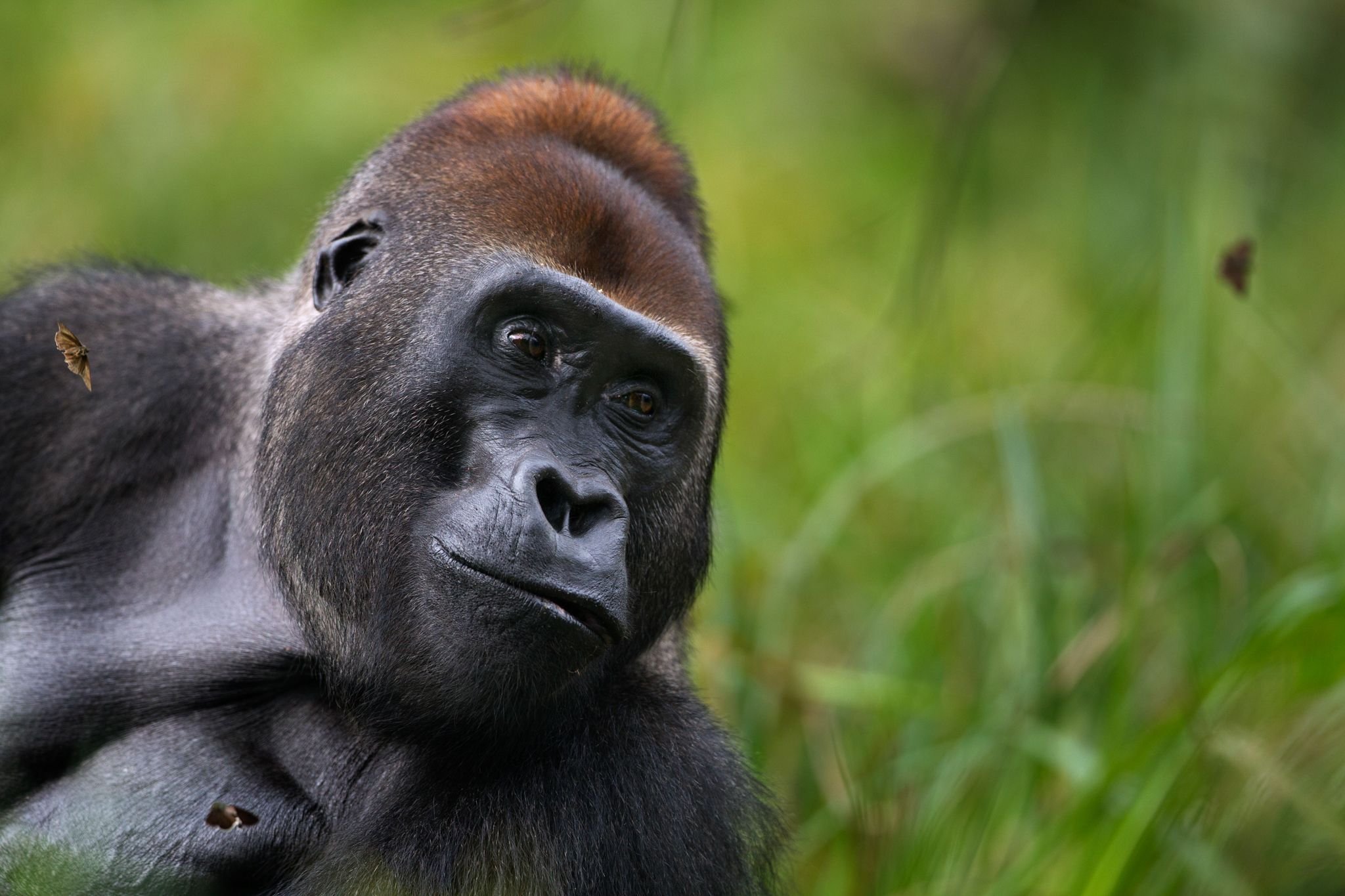
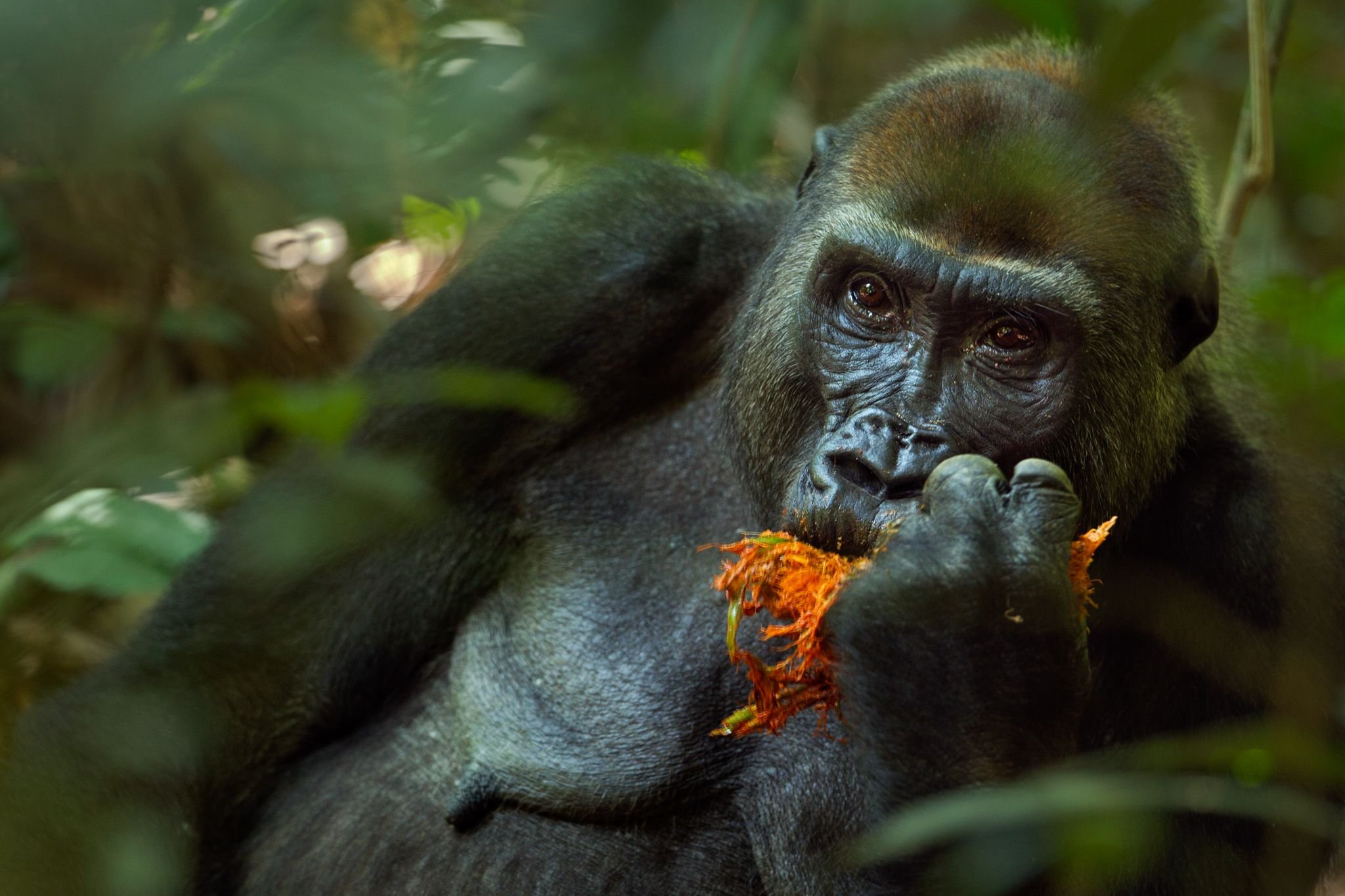
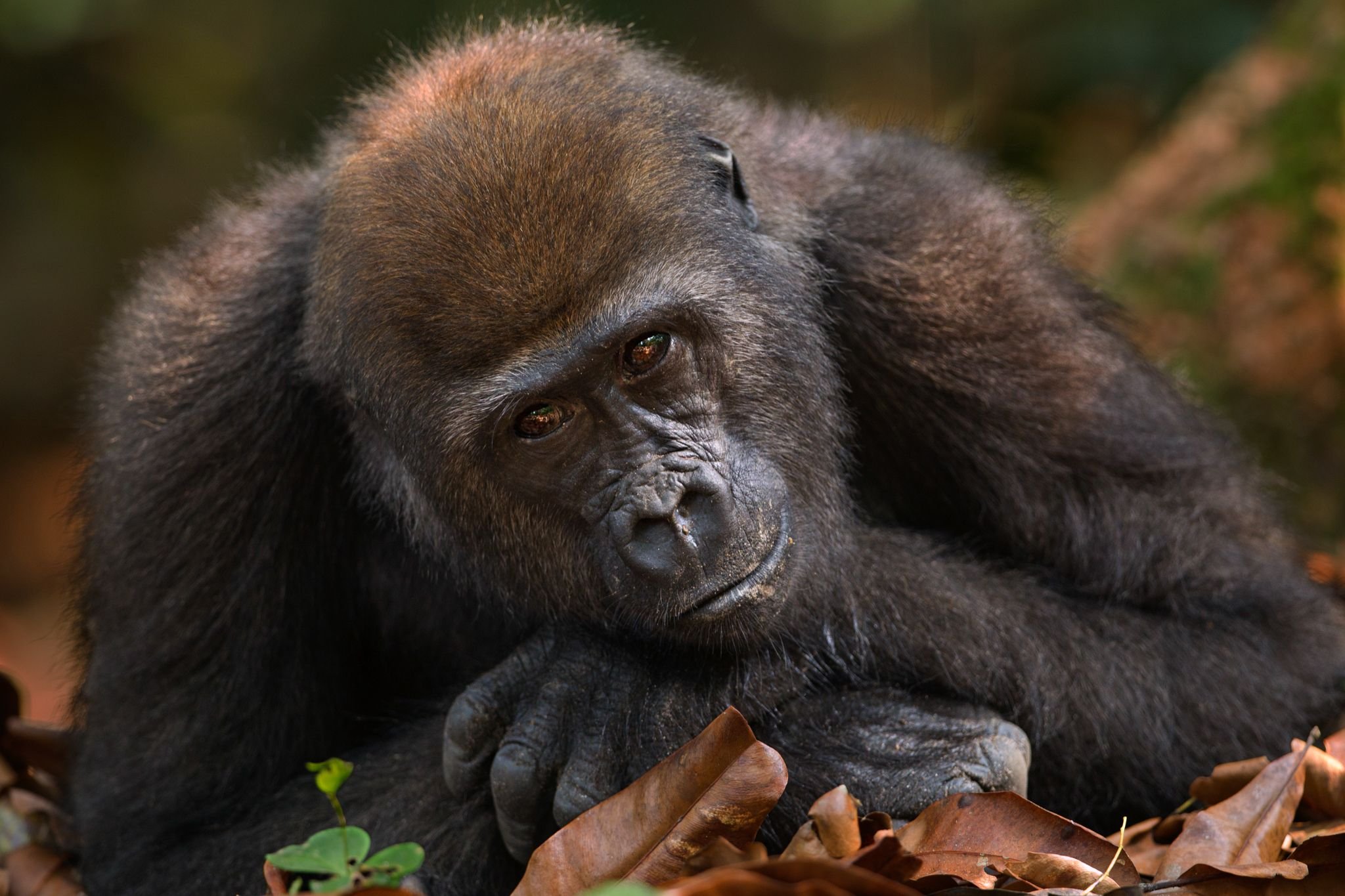
Makumba dictated the rhythms of the group’s daily movements, and it was his responsibility to maintain control over their home range. Unlike many animals, western lowland gorillas don’t defend strict territories—various families tend to have overlapping ranges—but they’re still wary of outsiders. “We once watched [Makumba] feeding quietly in a bai,” Shah recalled, referring to a marshy clearing in the forest. “There was a loud thwack on a tree trunk, undoubtedly indicating another silverback’s presence in the vicinity. Within seconds, Makumba (which means “with speed” in the local BaAka language) had covered over a hundred yards and disappeared into the dark forest to investigate.”
Aside from occasional disruptions like these, most of the gorillas’ daily life was calm, spent trekking through the forest in search of food. As the apes adjusted to the photographers’ continued presence, the silverback seemed to conclude that Shah and Rogers were harmless enough. The rest of the family followed his lead, especially the youngsters, which eventually began approaching the pair with great curiosity.
Aside from occasional disruptions like these, most of the gorillas’ daily life was calm, spent trekking through the forest in search of food. As the apes adjusted to the photographers’ continued presence, the silverback seemed to conclude that Shah and Rogers were harmless enough. The rest of the family followed his lead, especially the youngsters, which eventually began approaching the pair with great curiosity.
That these apes are still so mysterious is ironic. After all, they’re the gorillas most familiar to the majority of people. The famous sign-language-speaking Koko, for example, is a western lowland gorilla. And the gorillas one might find in nearly any zoo in the world (with the exception of a few in Holland) are western lowlands. In part, that’s because wild western lowland gorillas survived their initial transfers to captivity better than their mountain counterparts, which were uniquely adapted to high-altitude living.
Despite similarities in their appearance, western gorillas, which include the lowland subspecies, are distinct from eastern gorillas, such as the mountain gorilla (Gorilla beringei beringei). The two species are separated geographically by more than a thousand kilometers (well over 600 miles), with mountain gorillas confined to the highlands of East Africa and western lowland gorillas occupying the more expansive lowland forests of western Africa. The species are also genetically distinct. The two last shared a common ancestor some 2 million years ago, and today are at least as different from each other as chimpanzees are from bonobos.
Despite similarities in their appearance, western gorillas, which include the lowland subspecies, are distinct from eastern gorillas, such as the mountain gorilla (Gorilla beringei beringei). The two species are separated geographically by more than a thousand kilometers (well over 600 miles), with mountain gorillas confined to the highlands of East Africa and western lowland gorillas occupying the more expansive lowland forests of western Africa. The species are also genetically distinct. The two last shared a common ancestor some 2 million years ago, and today are at least as different from each other as chimpanzees are from bonobos.
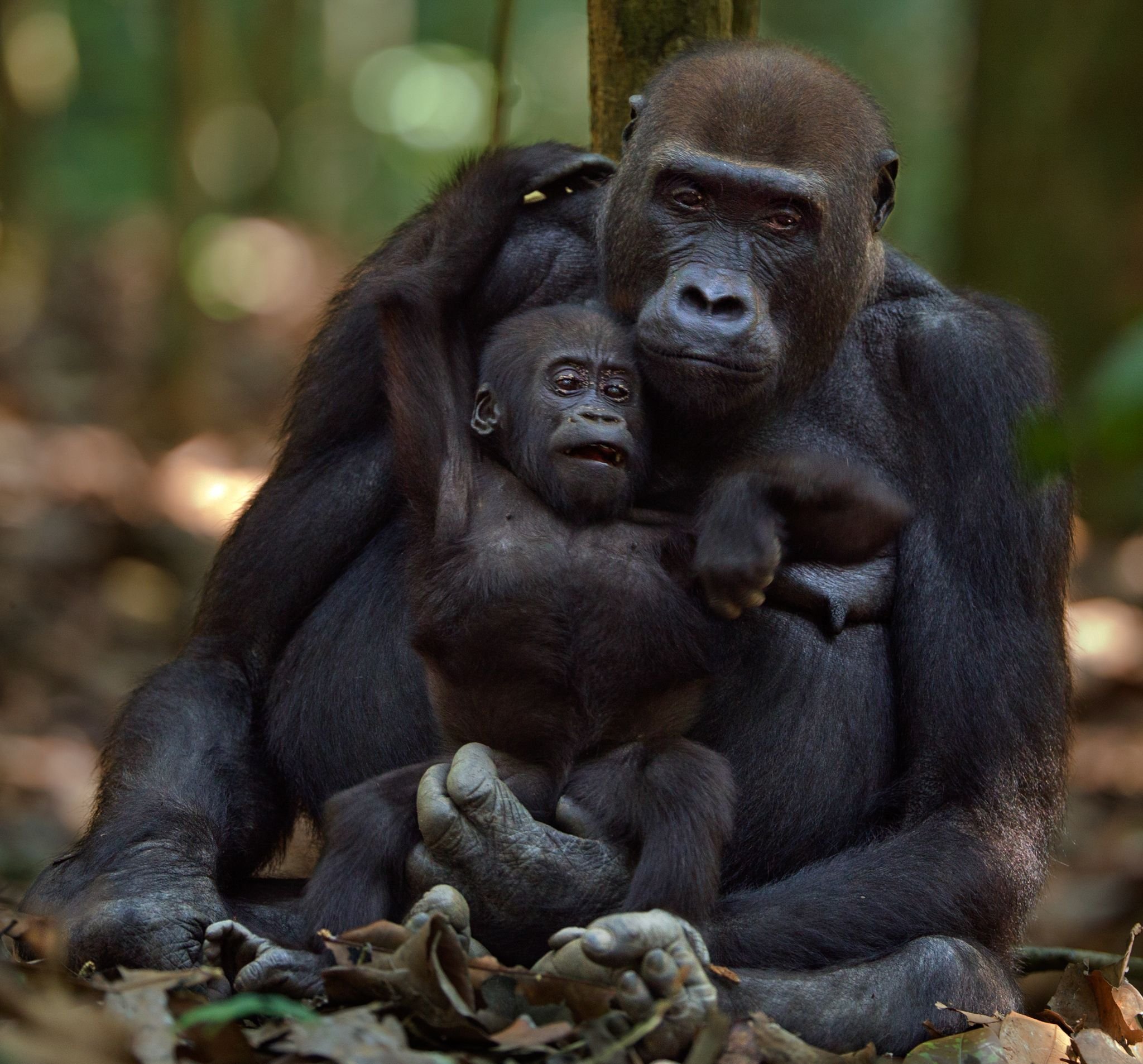
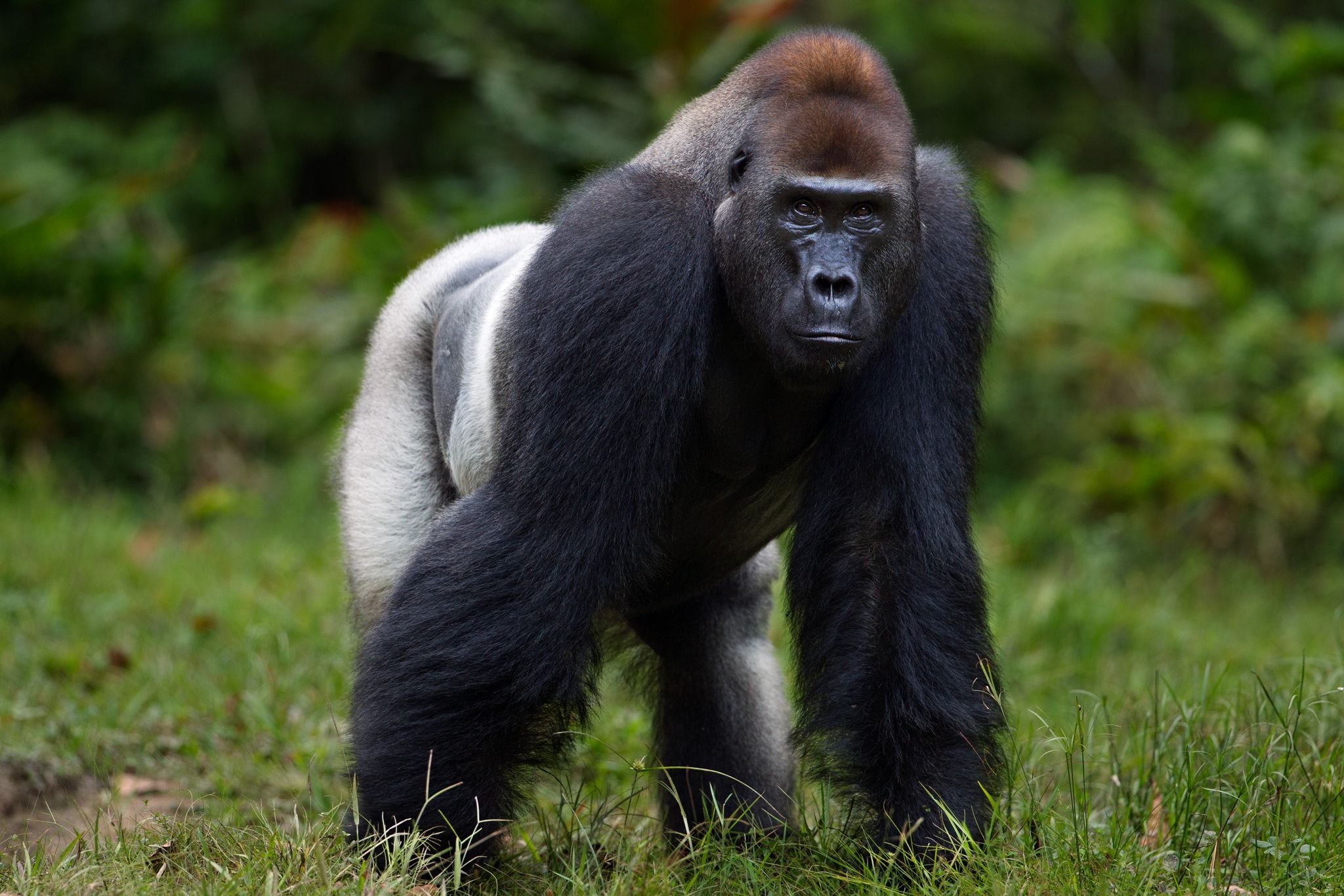
Although it’s tough to pin down precise population numbers, the International Union for Conservation of Nature (IUCN) estimates that there are at least a few hundred thousand western lowland gorillas in the wild. “About 98 percent of gorillas are western lowlands,” Williamson says, and more than 90 percent of the geographic range of all gorillas is comprised of western gorilla habitat. “In terms of numbers, they completely dominate the two species.” Despite these seemingly impressive numbers, the species still qualifies as endangered, due to a population decline of 80 percent over the past 60 years. In contrast, there are fewer than a thousand mountain gorillas left in the world. The majority dwell in the mountains of Uganda, Rwanda, and the Democratic Republic of the Congo. But thanks, in part, to the tourism industry that has sprung up around them, their numbers may now be increasing.
Mountain gorillas have proven easier to habituate than their lowland counterparts, mainly because of their habitat. In fact, most everything that differentiates mountain and lowland gorillas is driven by differences in their habitats. Mountain gorillas live at high altitudes, and enjoy a leafier diet. “They live in a salad bowl,” Williamson says, “so they don't travel very far.” This makes them much easier for tourist guides and researchers to locate. Plus, the rugged landscape with sparse trees makes it easy for a group of humans to sit on a slope, across the valley from a group of gorillas foraging on the opposite slope. Everyone can see each other, but at a safe distance. Over time, the distance can be decreased until eventually they realize that humans are not a threat and become disinterested. Mountain gorilla tourism has therefore taken off in their range, with as many as 50,000 people making the journey to East Africa each year.
Mountain gorillas have proven easier to habituate than their lowland counterparts, mainly because of their habitat. In fact, most everything that differentiates mountain and lowland gorillas is driven by differences in their habitats. Mountain gorillas live at high altitudes, and enjoy a leafier diet. “They live in a salad bowl,” Williamson says, “so they don't travel very far.” This makes them much easier for tourist guides and researchers to locate. Plus, the rugged landscape with sparse trees makes it easy for a group of humans to sit on a slope, across the valley from a group of gorillas foraging on the opposite slope. Everyone can see each other, but at a safe distance. Over time, the distance can be decreased until eventually they realize that humans are not a threat and become disinterested. Mountain gorilla tourism has therefore taken off in their range, with as many as 50,000 people making the journey to East Africa each year.
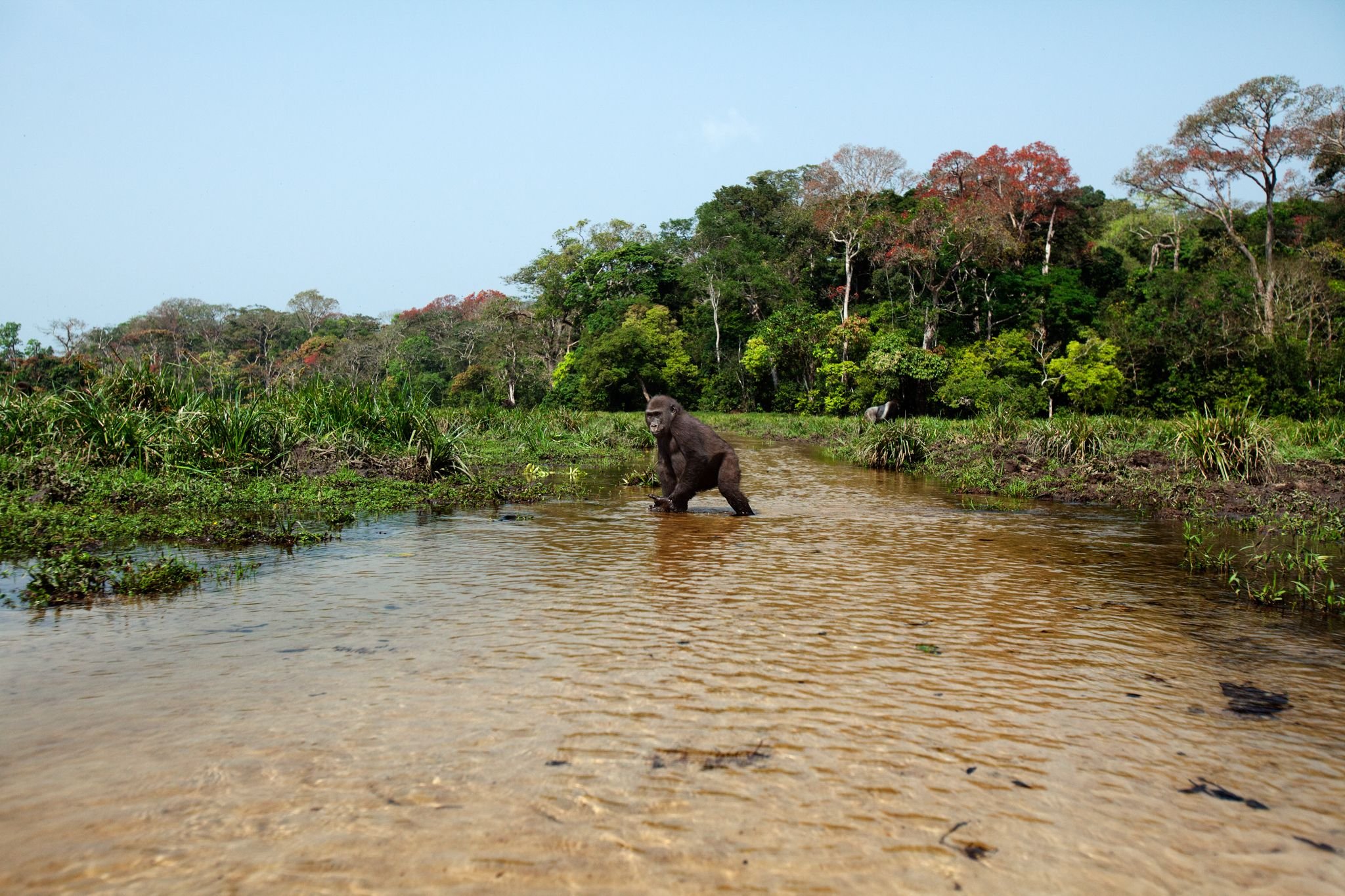
Tourism around the western lowland gorilla has been slower going, with at most a couple hundred visitors each year. That’s due to the challenges of habitat as well as habituation. Western lowland gorillas live off the fruit they find by clambering up trees distributed widely across their lowland range. The animals travel much farther, sometimes as much as 6 kilometers (4 miles) a day, in search of food. Finding and following the gorillas is therefore much more difficult. In addition, the tourism infrastructure doesn't exist yet in places like the Central African Republic or Gabon. There are no fancy lodges, and the roads are often impassable.
This issue of isolation is changing, though, for better and for worse. At one time, most lowland gorilla territory was extremely difficult to access. But logging and mining concessions first granted in the mid-1990s have resulted in the construction of an extensive network of roads through previously intact forests. Those roads, combined with minimal law enforcement, offer easy access for poachers aiming to kill gorillas and other animals, and to smuggle bushmeat and ivory out of the forest.
Those same roads could usher in more tourists to observe western lowland gorillas, which could ultimately help to protect the species, at least in principle. But it's a tough sell. Local and national governments stand to see higher revenues, at least in the short term, from logging and mining operations than from investing in the development of tourism infrastructure. And up to this point, few tourists have been willing to contend with the mosquitos and threat of malaria not present in mountain gorilla territory. Still, the efforts continue.
This issue of isolation is changing, though, for better and for worse. At one time, most lowland gorilla territory was extremely difficult to access. But logging and mining concessions first granted in the mid-1990s have resulted in the construction of an extensive network of roads through previously intact forests. Those roads, combined with minimal law enforcement, offer easy access for poachers aiming to kill gorillas and other animals, and to smuggle bushmeat and ivory out of the forest.
Those same roads could usher in more tourists to observe western lowland gorillas, which could ultimately help to protect the species, at least in principle. But it's a tough sell. Local and national governments stand to see higher revenues, at least in the short term, from logging and mining operations than from investing in the development of tourism infrastructure. And up to this point, few tourists have been willing to contend with the mosquitos and threat of malaria not present in mountain gorilla territory. Still, the efforts continue.
The first tourists to visit Makumba’s family arrived in 2005, after six years of continual exposure to researchers. Such habituation is unequivocally hard on the gorillas, despite scientists’ efforts to keep anxiety to a minimum. “It breaks your heart when you realize the stress they go through,” Shah says.
Still, primatologist Martha Robbins, from the Max Planck Institute for Evolutionary Anthropology, argues that habituation is necessary. She points out that scientists must understand western gorillas well enough to protect them. “If we said ‘No more habituated gorillas,’ I think it would really be a step backwards for gorilla conservation,” she says. “If we can't explain to people the details of wildlife, there will be zero interest in protecting it and conserving it.”
Still, primatologist Martha Robbins, from the Max Planck Institute for Evolutionary Anthropology, argues that habituation is necessary. She points out that scientists must understand western gorillas well enough to protect them. “If we said ‘No more habituated gorillas,’ I think it would really be a step backwards for gorilla conservation,” she says. “If we can't explain to people the details of wildlife, there will be zero interest in protecting it and conserving it.”
The tourism experiment can’t fail.
Decades of scientific monitoring have proven that once gorillas are fully habituated, their stress levels go down, Robbins adds. She also points out that habituated mountain gorillas have higher levels of population growth than unhabituated ones, ostensibly because they benefit from ongoing veterinary care. If a habituated gorilla is caught in a snare, veterinarians can remove it and treat the wound; an unhabituated gorilla in a similar situation might never be found.
Robbins also thinks that local communities are more motivated to protect gorillas when they know there's an economic benefit from tourism. Combined with the extra medical attention they receive, this could explain the overall population increase recently observed for the critically endangered mountain gorillas.
Robbins also thinks that local communities are more motivated to protect gorillas when they know there's an economic benefit from tourism. Combined with the extra medical attention they receive, this could explain the overall population increase recently observed for the critically endangered mountain gorillas.
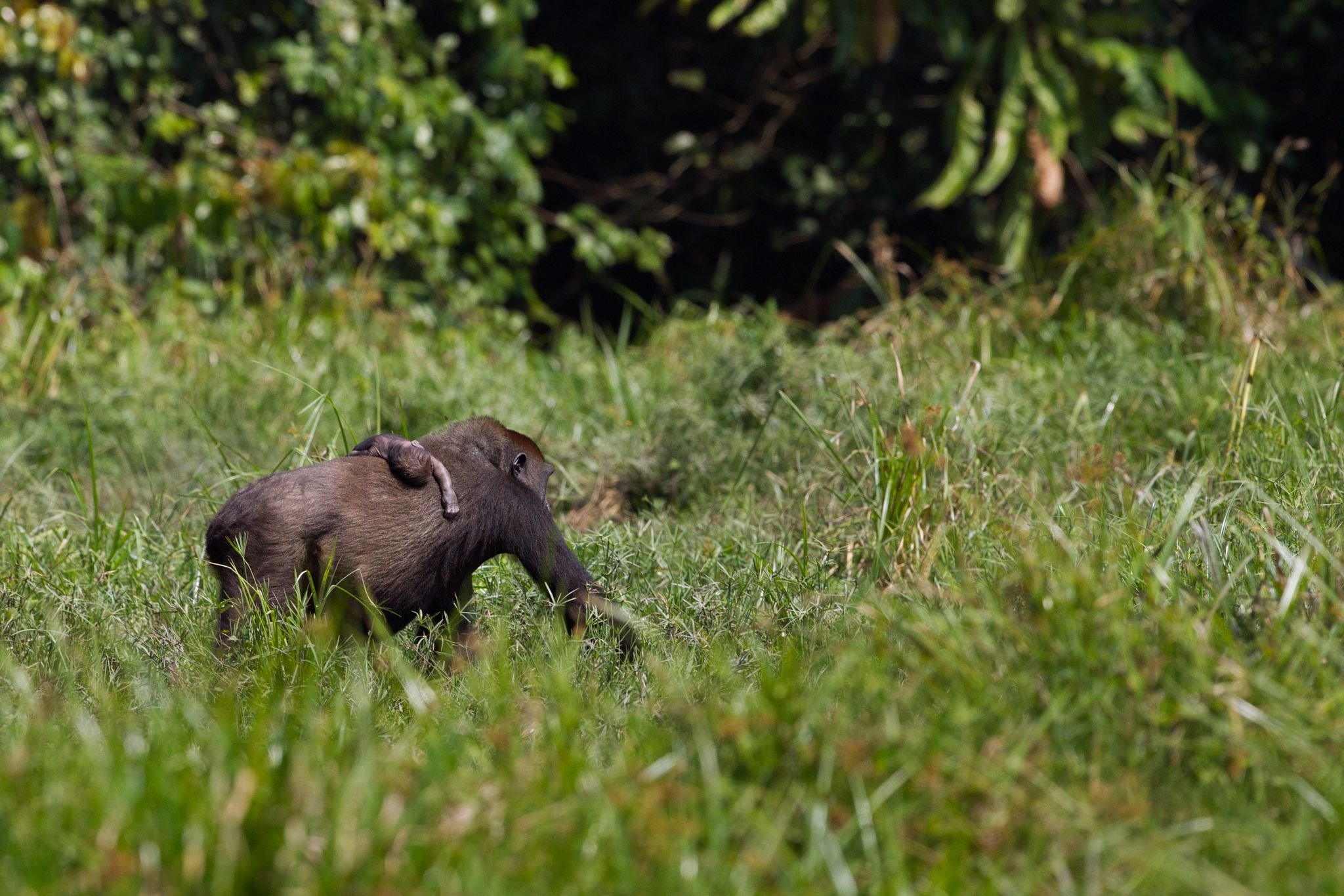
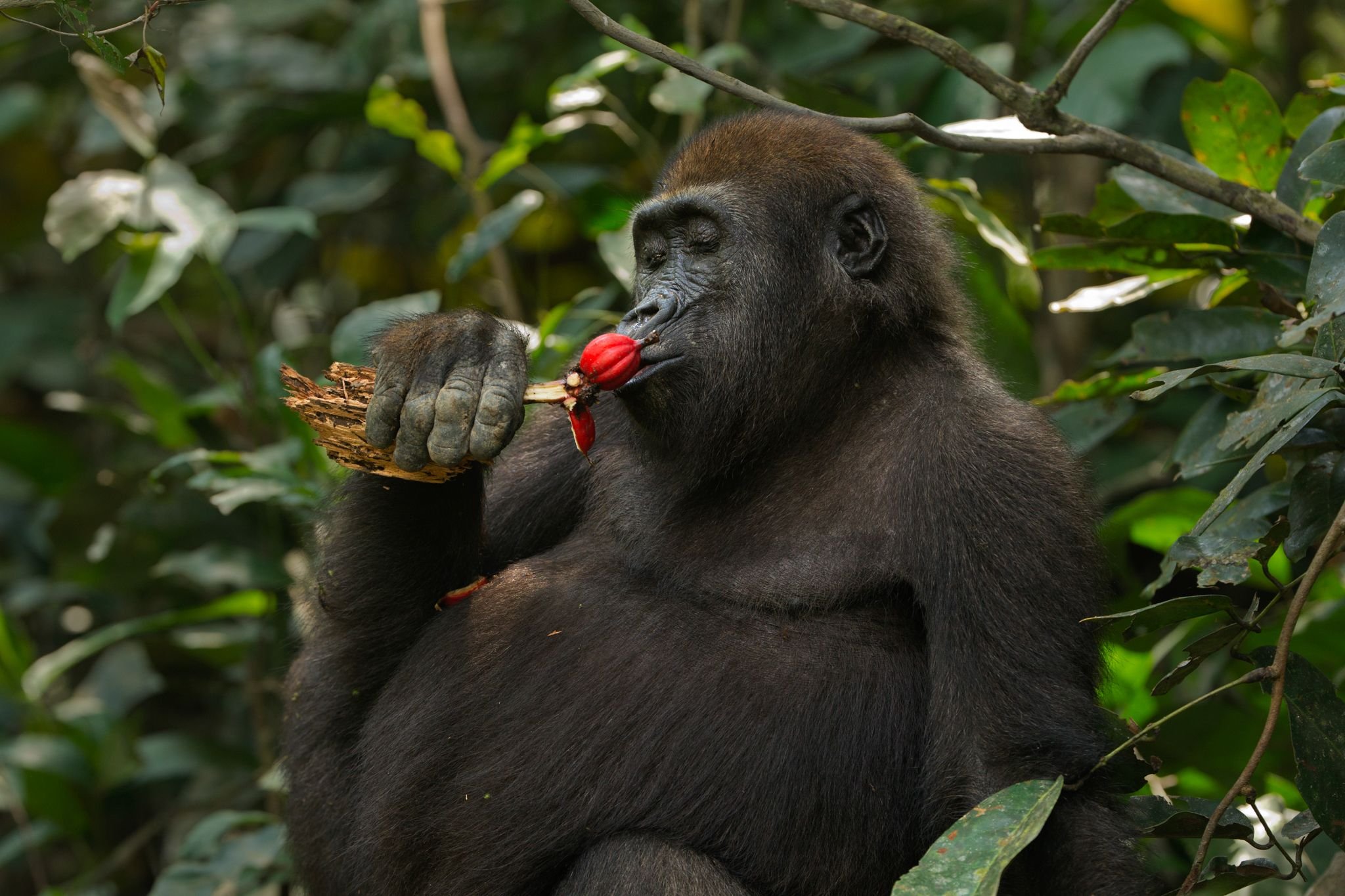
Williamson agrees, but emphasizes that habituating gorillas comes with a tremendous long-term responsibility. The tourism experiment can’t fail. “You have to know to the best of your ability that you're going to have funding in perpetuity,” she says. “If [the gorillas] lose their fear of humans, they're too easy to approach and kill.” Indeed, poaching, combined with the habitat degradation that enables it, still remains an important threat to the survival of lowland gorillas. (The other main threat, especially for populations along the Gabon-Congo border, is the transmission of Ebolavirus, the virus that causes Ebola in humans and other mammals.)
At least one thing is certain: Without a history of habituation, Shah and Rogers would surely not have been able to glimpse the quiet lives of these forest giants. Nor could they share the animals’ amazing, if perilous, existence with the rest of the world. “Once they work out that you are harmless, then you have an unbelievable experience,” Shah says. Despite having photographed many intelligent creatures, including big cats, he says great apes are unique. It’s eerie, he says. “You find that they are studying you. I love that the tables are turned.”
At least one thing is certain: Without a history of habituation, Shah and Rogers would surely not have been able to glimpse the quiet lives of these forest giants. Nor could they share the animals’ amazing, if perilous, existence with the rest of the world. “Once they work out that you are harmless, then you have an unbelievable experience,” Shah says. Despite having photographed many intelligent creatures, including big cats, he says great apes are unique. It’s eerie, he says. “You find that they are studying you. I love that the tables are turned.”
Photographs by Anup Shah and Fiona Rogers
Original article can be accessed here: http://www.biographic.com/posts/sto/the-forest-between-us?utm_content=buffer40b5b&utm_medium=social&utm_source=twitter.com&utm_campaign=buffer
Related items
- You are here:
-
Home

- News









